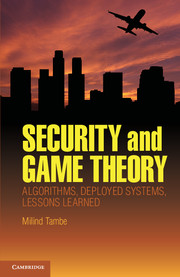Book contents
- Frontmatter
- Contents
- Acknowledgments
- 1 Introduction and Overview of Security Games
- PART I SECURITY EXPERTS' PERSPECTIVES
- PART II DEPLOYED APPLICATIONS
- PART III EFFICIENT ALGORITHMS FOR MASSIVE SECURITY GAMES
- PART IV FUTURE RESEARCH
- 10 Effective Solutions for Real-World Stackelberg Games: When Agents Must Deal with Human Uncertainties
- 11 Approximation Methods for Infinite Bayesian Stackelberg Games: Modeling Distributional Payoff Uncertainty
- 12 Stackelberg versus Nash in Security Games: Interchangeability, Equivalence, and Uniqueness
- 13 Evaluating Deployed Decision-Support Systems for Security: Challenges, Analysis, and Approaches
- PART V SHORT BIOS
- References
- Index
- References
11 - Approximation Methods for Infinite Bayesian Stackelberg Games: Modeling Distributional Payoff Uncertainty
from PART IV - FUTURE RESEARCH
Published online by Cambridge University Press: 05 January 2012
- Frontmatter
- Contents
- Acknowledgments
- 1 Introduction and Overview of Security Games
- PART I SECURITY EXPERTS' PERSPECTIVES
- PART II DEPLOYED APPLICATIONS
- PART III EFFICIENT ALGORITHMS FOR MASSIVE SECURITY GAMES
- PART IV FUTURE RESEARCH
- 10 Effective Solutions for Real-World Stackelberg Games: When Agents Must Deal with Human Uncertainties
- 11 Approximation Methods for Infinite Bayesian Stackelberg Games: Modeling Distributional Payoff Uncertainty
- 12 Stackelberg versus Nash in Security Games: Interchangeability, Equivalence, and Uniqueness
- 13 Evaluating Deployed Decision-Support Systems for Security: Challenges, Analysis, and Approaches
- PART V SHORT BIOS
- References
- Index
- References
Summary
Introduction
Stackelberg games are increasingly important for informing real-world decision making, including a growing body of work that applies these techniques in security domains such as critical infrastructure protection (Bier, 2007; Sandler and D. G. A. M., 2003), computer networks (Alpcan and Basar, 2003; Nguyen and Basar 2009), and robot patrolling strategies (Agmon et al., 2009; Basilico, Gatti, and Amigoni, 2009; Gatti, 2008). Two software systems that use this type of game modeling are in use by the the Los Angeles International Airport (LAX) (Pita et al., 2008) and the Federal Air Marshals Service (FAMS) (Tsai et al., 2009) to assist with resource allocation decision. A key issue that has arisen in these applications is whether the models can accurately represent the uncertainty that domain experts have about the inputs used to construct the game models, including the preferences and capabilities of terrorist adversaries.
To apply game-theoretic reasoning, the first step in the analysis is to construct a precise game model. The typical approach (e.g., in the LAX and FAMS applications) is to construct a model using a combination of the available data and expert opinions. Unfortunately, the data is often limited or imprecise, especially in regard to information about the terrorist adversaries. For example, it can be difficult to predict precisely how attackers will weigh casualties, economic consequences, media exposure, and other factors when selecting targets.
- Type
- Chapter
- Information
- Security and Game TheoryAlgorithms, Deployed Systems, Lessons Learned, pp. 213 - 232Publisher: Cambridge University PressPrint publication year: 2011
References
- 24
- Cited by

